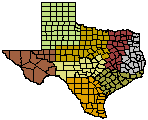- Trans Pecos
- High Plains/Panhandle
- Cross Timbers
- Hill Country
- Post Oak Savannah
- Pineywoods
- Oak Prairie
- South Texas Plains

Wildlife Division District Map
Nongame Wildlife
Many nongame animals are not actively hunted in Texas. For that reason, most go unnoticed by the vast majority of people. However, there are a growing number of people that actively seek out and/or manage for nongame wildlife species such as birds, butterflies, bats, reptiles and amphibians for the pure enjoyment of watching or photography. While game animals are a tremendous resource, the nongame species available for all our enjoyment far outnumber those high profile game species, yet people tend to overlook them. Whether it be a hummingbird drinking from a back porch feeder, or a majestic bald eagle glimpsed on an otherwise slow day of duck hunting, the presence of nongame animals enrich our daily lives. Back yard bird feeding is another popular activity people enjoy.
The 43 counties which make up the Possum Kingdom Wildlife District in Northcentral Texas encompass parts of 4 major ecological regions; Cross Timbers and Prairies, Rolling Plains, Blackland Prairie, and Edwards Plateau Ecological Regions. Within this area one can visit the oak forests of the West and East Cross Timbers, imagine herds of bison grazing on the Blackland and Fort Worth Prairies, try to catch a glimpse of a black capped vireo in the northern Edwards Plateau, or travel some desolate country road in the Rolling Plains. If you know where and how to look, the opportunities exist to experience many different species of wildlife in a single weekend.

Fortunately landowners are finding ways to help offset the effects of
fragmentation on wildlife habitat. For example, H.B. 1358,
implemented the constitutional amendment by making wildlife management an
agricultural use that qualifies land for agricultural appraisal. Another way
landowners are conserving habitat is by forming
Wildlife Management
Co-ops.
Through cooperative management planning, neighboring landowners effectively
conserve larger tracts of habitat than could be conserved as individuals. While
most wildlife coops are started by a common desire to manage game species, a
direct byproduct of sound habitat management results in improved habitat for a
suite of species, including many nongame animals. Click for more information on
habitat management for
nongame wildlife (PDF 298.4 KB).
(PDF 298.4 KB).